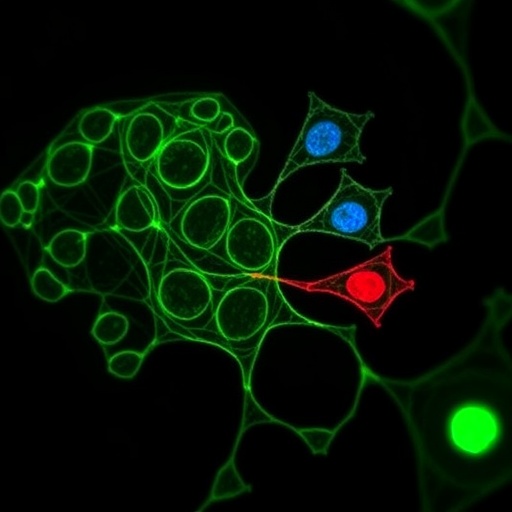In the ever-evolving landscape of cancer research, the quest to understand the intricate mechanisms that govern tumor growth and metastasis remains a vanguard of scientific inquiry. Recently, a noteworthy study has surfaced that throws light on the activation of CST1 transcription by TFAP2C, a phenomenon that appeared to play a significant role in breast cancer progression as well as the suppression of ferroptosis. This revelation, however, has since been followed by a retraction that raises more questions than it answers.
The enigmatic nature of breast cancer progression has long intrigued researchers seeking to identify the pathways that facilitate the malignancy’s aggressive nature. TFAP2C, a member of the transcription factor AP-2 family, should be viewed as a pivotal player in this biological drama. Its role extends beyond merely influencing gene expression—TFAP2C orchestrates a myriad of cellular responses that can either foster or hinder cancer development. By activating CST1 transcription, TFAP2C was initially thought to create an environment conducive to tumor growth, manipulating the cancer cell’s innate machinery for its advantage.
Ferroptosis, a form of regulated cell death characterized by iron-dependent lipid peroxidation, has recently emerged as a critical area of focus in cancer research. Unlike apoptosis, which plays a well-documented role in cancer, ferroptosis presents a unique set of challenges for malignancies. The initial hypothesis posited that the activation of CST1 through TFAP2C would suppress this lethal mechanism, allowing cancer cells to survive in harsh environmental conditions, thus propelling the progression of breast cancer. This process, believed to blur the lines between cell survival and death, has captured the attention of oncologists and cell biologists alike.
Upon further scrutiny, the research team comprising Yuan, Zhou, and Li found compelling evidence linking the transcriptional activity of TFAP2C to the regulation of CST1. This relationship was underscored by a series of experiments that indicated a direct correlation not only between the presence of TFAP2C and CST1 levels but also between CST1 expression and enhanced tumor aggressiveness. Moreover, the intricate interplay between these components appeared to confer a survival advantage to the cancer cells, raising the stakes for targeted therapeutic interventions.
However, the clarity offered by these findings rapidly faded when a retraction was issued, questioning the data’s robustness. Such occurrences are not uncommon in the scientific community, where preliminary findings undergo rigorous peer review and experimental validation. The retraction serves as a cautionary tale, emphasizing the necessity for reproducibility in science, particularly in studies that have significant implications for clinical applications. While the initial study purported to shed light on the mechanisms underlying breast cancer, the subsequent withdrawal of its findings leaves a gap in the understanding that researchers must now grapple with.
The fallout from the retraction extends beyond theoretical implications; it also casts a long shadow over ongoing research and regulatory pathways. Pharmaceutical companies and research institutions readily monitor breakthroughs with the potential for therapeutic development, and a retracted study can slow momentum. Researchers now find themselves at a crossroads, needing to reassess their methodologies and validate findings independently, especially when proposing novel cancer therapies.
Importantly, this incident raises critical questions regarding the peer review process and the accountability of researchers. It illustrates the delicate balance that exists between the excitement of discovery and the commitment to scientific integrity. As the community collectively processes this debacle, a renewed emphasis on methodological rigor will likely emerge. By implementing stronger oversight protocols, the scientific community can enhance the reliability of findings that ultimately shape the future of cancer treatment.
Moving forward, one can appreciate the complexity of biochemical interactions at play in cancer malignancy. The role of TFAP2C as a potential therapeutic target may continue to be explored, provided future studies adopt a more robust experimental design. Researchers may wish to delve deeper into the relationship between TFAP2C and CST1, employing multifaceted approaches that include genetic modeling and biochemical assays to reinforce their findings.
It is also crucial for upcoming studies to remain vigilant about the phenomena of ferroptosis and its regulatory mechanisms. Understanding how various factors modulate this form of cell death could reveal novel angles for cancer therapy, particularly in cancers known for their resistance to conventional treatments. In this context, every setback must be treated as an opportunity for scientific growth and discovery.
Finally, as the dust settles on this retraction, one can only hope that the lessons learned will stimulate new inquiries and inspire more resilient scientific practices. The truth about cancer is often elusive, but the pursuit of knowledge must persist. Through tireless research and stringent verification, the scientific community can work towards illuminating even the darkest corners of cancer biology. In the end, it is the collaborative effort among researchers, clinicians, and patients that will fuel innovation and ultimately lead to breakthroughs in our fight against cancer.
Overall, this incident serves as a profound reminder of the complexities inherent in biomedical research and the necessity of critical examination of the science we consume. As we strive to unlock the secrets of cancer, a commitment to ethical practices and high-quality research will be paramount in our collective goal to combat this formidable disease.
Subject of Research: TFAP2C and its role in breast cancer progression and ferroptosis suppression.
Article Title: Retraction Note: TFAP2C Activates CST1 Transcription to Facilitate Breast Cancer Progression and Suppress Ferroptosis.
Article References:
Yuan, L., Zhou, D., Li, W. et al. Retraction Note: TFAP2C Activates CST1 Transcription to Facilitate Breast Cancer Progression and Suppress Ferroptosis. Biochem Genet (2025). https://doi.org/10.1007/s10528-025-11267-0
Image Credits: AI Generated
DOI:
Keywords: TFAP2C, CST1, breast cancer, ferroptosis, transcription factors, cancer progression, retraction, scientific integrity.




